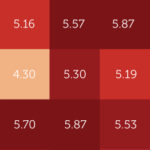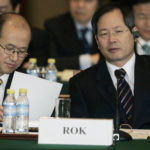December 4, 2017, by Marie DuMond—
South Korea and the United States generally share similar estimations of China’s and Japan’s blind spots in a unification scenario. Both believe that Beijing has the most prominent blind spot on domestic stabilization and refugees, and that Japan shares similar concerns, suggesting that all four powers could prioritize law and order in a unification scenario.
November 22, 2017, by Marie DuMond—
On November 22, predictive signals by Predata/CSIS Beyond Parallel indicate there is an elevated likelihood of a North Korean WMD activity in the next 14 to 30 day windows. The likelihood of WMD activity in the coming weeks is tempered by the fact that, historically, North Korea has not conducted many tests in the November and December timeframe.
November 13, 2017, by Marie DuMond—
Beyond Parallel’s first-ever survey of expert assessments on unification-related issues indicate South Korea and the United States share the common view that domestic stabilization and unification costs constitute the most critical unification blind spots with a high degree of concern but low levels of knowledge for both countries.
November 3, 2017, by Lisa Collins and Sang Jun Lee—
Predictive analytics by PreData/CSIS Beyond Parallel for missile tests and WMD activity indicate that the underlying signals for both the 14-day prediction level has been trending downward since October 24, 2017... PreData/CSIS Beyond Parallel predictive analytics for North Korean missile tests and WMD activity indicate that…
October 18, 2017, by Marie DuMond—
Domestic stabilization is the most critical issue with unification for South Korean officials and experts, registering the highest composite score (i.e., high level of concern and low level of knowledge). This means civil-military relations, law and order, and stability in the North represent the issues for which Koreans see great consequences for national interests, but for which they have little prior knowledge or understanding. Hence, it is the greatest potential “blind spot” of unification. Costs related to unification rank a close second for South Koreans, followed by refugees, nuclear weapons, and human rights.
October 2, 2017—
The debate over how to deal with North Korea’s nuclear program has been raging for nearly 25 years. In this study, CSIS Beyond Parallel collected information on negotiations between the U.S. and North Korea to shed light on the present nuclear dilemma.
September 22, 2017, by Marie DuMond—
Predata-Beyond Parallel signals indicate there is a significantly elevated chance of North Korea conducting a missile test in the next 30-days and an elevated likelihood of North Korea conducting a missile test in the next 14-days... [footer] Elevated chance of a North Korean missile test in the next 14 days.…
September 7, 2017, by Marie DuMond—
On September 7, predictive signals by Predata/CSIS Beyond Parallel indicate there is a significantly elevated chance of a North Korean missile test in the next 14 days. The underlying signal has been breaching its highest levels each day since August 31, reaching its highest level in 102 days on September 5 and exceeding its 30-day trailing average by 2.5 standard deviations. The signal continued to show significant overnight increases through September 6.
August 9, 2017—
The objective of the Six Party Talks was to resolve the North Korean nuclear problem through multilateral negotiations. In this Living History interview, Ambassador Chun Yung-woo reflects upon his experience negotiating with the Americans, Chinese and North Koreans during the Six Party Talks and also discusses his later role as National Security Advisor to ROK President Lee Myung-bak.
July 4, 2017—
North Korea launched a land-based, intermediate range ballistic missile from North Pyongan province that flew for 37 minutes and 933 km (580 miles) in the morning of July 4. CSIS Beyond Parallel data analytics finds a two-week provocation window under Kim Jong-un after U.S.-ROK summits. We should expect more provocations to come.










